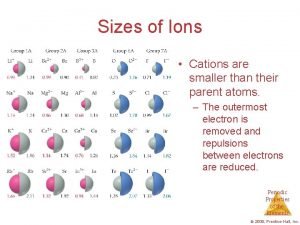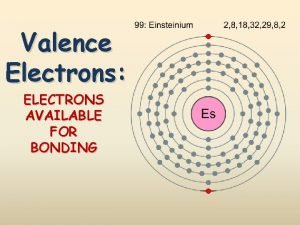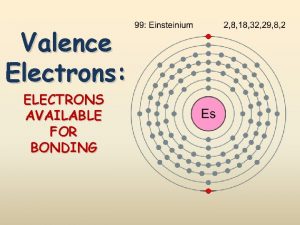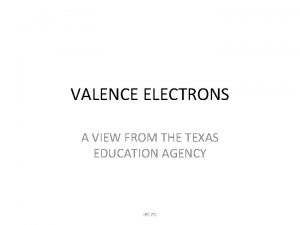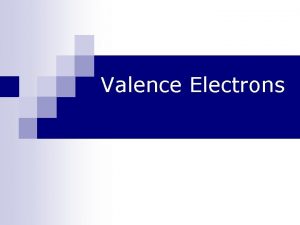Add up valence electrons for all atoms Cations









- Slides: 9

Add up valence electrons for all atoms Cations – lose electrons: subtract the charge Anion – gain electrons: add the charge Calculate Number of Valence Electrons Ex: NH 4+ N = 5 4 (H) = 4(1) Charge = -1 Valence e- = 8 Build a Trial Structure H N Remaining e- = Valence e- - 2 (# of Bonds) O H O C O H Valence e- : Count the electrons left after making your trial structure C = 4 3 (O) = 3(6) Charge = +2 Valence e- = 24 H Build a Trial Structure Using the Following Guidelines 1. Place the least EN element in the middle 2. Arrange other atoms around it to make molecules as symmetrical as possible 3. Draw one bond connecting atoms together 4. H makes 1 bond (never in middle) 5. F, Cl, Br, I form 1 bond (in CHE 101) (never in the middle) 6. Oxygen never bonds to oxygen (in CHE 101) 7. Typical Bonding Patterns – H=1, O = 1 or 2, C =4, N = 1, 2, 3 and rarely 4 (if it is part of a polyatomic ion). Ex: CO 3 -2 Count Electron Left 8 - 2 (# of Bonds): – 2·(4) Remaining e-: 0 Valence e- : 24 - 2 (# of Bonds): – 2·(3) Remaining e-: 18

Distribute Electrons 1. After you have made your trial structure, start to complete octets until you run out of electrons. 2. Start with the most EN element first. 3. Remember H has an “octet” with 2 electrons H N H O C If all atoms have complete octets = Done! If some atoms can’t complete octets remove unshared electron pairs and form double or triple bonds. Share the lone pair of electrons O on oxygen with the carbon to complete O C O carbons octet. Remember to put cations/anions in brackets and include the charge +1 H N H O H Complete Octets H O H Distribute electrons to complete octets (noble gas configurations) -2 O H O C O

Valence Shell Electron Pair Repulsion Theory (VSEPR) VSEPR Theory predicts the shapes of molecules by realizing that electrons will repulse each other and seek to stay as far apart as possible. It depends on the number of atoms bonded and the number of lone pairs around the central atom. This leading to the following idealized molecular shapes: # atoms Bonded # lone pairs Shape Bond Angle 4 0 Tetrahedral 109. 5 3 1 Trigonal Pyramidal 109. 5 2 2 Bent - 109. 5 3 0 Trigonal Planar 120 2 1 Bent - 120 2 0 Linear 180 Determine the Shape and Bond Angle +1 H H N -2 O H O C O H 4 atoms, 0 lone pair Tetrahedral – 109. 5 3 atoms, 0 lone pair Trigonal Planar – 120 Polarity Nonpolar or Dipolar Nonpolar – symmetrical distribution of electron density around a molecule. Dipolar – unsymmetrical distribution of electron density around a molecule. Molecule will behave like a magnet. +1 H H N -2 O H O C O H Symmetrical therefore Nonpolar

A few more examples… Bicarbonate Anion (HCO 3 -1) Phosphorus Trifluoride (PF 3) 1. Count Valence Electron P = 5 3 (F) = 3(7) Valence e- = 26 2. Trial Structure F P F H = 1 C = 4 3 (O) = 3(6) Anion (add) = 1 Valence e- = 24 O H 3. Remaining Electrons Valence e- : F 3. Remaining Electrons Valence e- : 2. Trial Structure 1. Count Valence Electron 26 O C 4. Complete Octets/Share e- 24 O - 2 (# of Bonds): – 2·(4) H Remaining e-: 16 O C O - 2 (# of Bonds): – 2·(3) Remaining e-: 20 4. Complete Octets F P F 5. Shapes 6. Polarity 3 atoms, 1 lone pair Trigonal Pyramidal – 109. 5 Unsymmetrical Molecule Therefore Dipolar -1 O H O 2 atoms, 2 lone pair Bent – 109. 5 C O O Don’t forget the brackets for ions Unsymmetrical Molecule Therefore Dipolar 3 atoms, 0 lone pair Trigonal Planar – 120 Share the lone pair of electrons on oxygen with the carbon to complete carbons octet.

Resonance Structures occur when more than 1 correct Lewis Structure can be drawn for a molecule (having the same skeletal formula). The molecule in nature is the average of the correct Lewis Structures. This is important because experimentally we observe the resonance structure, not the individual structures. Resonance Structures (CHE 111 only) The individual Lewis Structures for the NO 3 -1 ion have 2 single bonds and 1 double bond. Theoretically we can measure the difference between the two. However, experimentally, we see only 1 type of bond (represented by the hybrid structure). Formal Charges Dfn: A formal charge is the difference between the number of valence electrons an atom normally has and the number of electrons it has in a molecule. Polyatomic ions result in atoms with Formal Charges In cases where there is more than one correct Lewis Structure the one with the lowest FC is correct +1 H Formal Charges (CHE 111 only) H N H H -2 Double Check: Sum FC = overall charge on ion O O C Double Check: The sum of the FC = -2 which is equal to the charge on the ion. O

Incomplete Octets – molecules with fewer than 8 electrons can’t complete octets but can still form molecules can form molecules. Generally occurs for Be and B. Cl Be F Cl B Odd Number of Electrons– molecules with an odd number of electrons are often called Free Radicals. They are very reactive and tend to be short lived. Violating the Octet Rule (CHE 111 only) F F N O Expanded Octets: Elements in the 3 rd row and below can access d-orbitals and have 12 (occasionally even 14) electrons. This generates 7 new shapes for molecules to have. or 5 atoms, 0 lone pairs Trigonal Pyramidal or # atoms Bonded # lone pairs Shape Bond Angle 6 0 Octahedral 90 5 1 Square Pyramidal 90 4 2 Square Planar 90 6 atoms, 0 lone pairs Octahedral or 5 atoms, 1 lone pairs Square Pyramidal # atoms Bonded # lone pairs 5 0 Shape Bond Angle Trigonal Bypyramidal 90 – Perp. 120 – In Plane 4 1 Seesaw Complex 3 2 T-Shaped 90 2 0 Linear 180 or or 4 atoms, 2 lone pairs Square Planar 2 atoms, 3 lone pairs Linear or 4 atoms, 1 lone pairs Seesaw or 3 atoms, 2 lone pairs T-Shape


-2 O O C O H H N H O O C O H F P F F

# atoms Bonded # lone pairs 5 Shape Bond Angle 0 Trigonal Bypyramidal 90 – Perp. 120 – In Plane 4 1 Seesaw Complex 3 2 T-Shaped 90 2 0 Linear 180 or or # atoms Bonded # lone pairs Shape Bond Angle 6 0 Octahedral 90 5 1 Square Pyramidal 90 4 2 Square Planar 90
 Atoms with 4 valence electrons
Atoms with 4 valence electrons How to find electrons
How to find electrons How do chemists model the valence electrons of metal atoms?
How do chemists model the valence electrons of metal atoms? How do chemists model the valence electrons of metal atoms?
How do chemists model the valence electrons of metal atoms? Are anions smaller than their parent atoms
Are anions smaller than their parent atoms Valence electrons periodic table
Valence electrons periodic table Valence electrons for transition metals
Valence electrons for transition metals Transition metals valence electrons
Transition metals valence electrons Valence electrons of each group
Valence electrons of each group Group 1 valence electrons
Group 1 valence electrons




